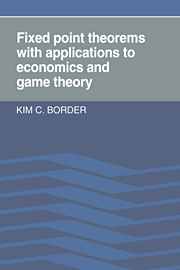Book contents
- Frontmatter
- Contents
- Preface
- 1 Introduction: models and mathematics
- 2 Convexity
- 3 Simplexes
- 4 Sperner's lemma
- 5 The Knaster-Kuratowski-Mazurkiewicz lemma
- 6 Brouwer's fixed point theorem
- 7 Maximization of binary relations
- 8 Variational inequalities, price equilibrium, and complementarity
- 9 Some interconnections
- 10 What good is a completely labeled subsimplex
- 11 Continuity of correspondences
- 12 The maximum theorem
- 13 Approximation of correspondences
- 14 Selection theorems for correspondences
- 15 Fixed point theorems for correspondences
- 16 Sets with convex sections and a minimax theorem
- 17 The Fan-Browder theorem
- 18 Equilibrium of excess demand correspondences
- 19 Nash equilibrium of games and abstract economies
- 20 Walrasian equilibrium of an economy
- 21 More interconnections
- 22 The Knaster-Kuratowski-Mazurkiewicz-Shapley lemma
- 23 Cooperative equilibria of games
- References
- Index
15 - Fixed point theorems for correspondences
Published online by Cambridge University Press: 16 January 2010
- Frontmatter
- Contents
- Preface
- 1 Introduction: models and mathematics
- 2 Convexity
- 3 Simplexes
- 4 Sperner's lemma
- 5 The Knaster-Kuratowski-Mazurkiewicz lemma
- 6 Brouwer's fixed point theorem
- 7 Maximization of binary relations
- 8 Variational inequalities, price equilibrium, and complementarity
- 9 Some interconnections
- 10 What good is a completely labeled subsimplex
- 11 Continuity of correspondences
- 12 The maximum theorem
- 13 Approximation of correspondences
- 14 Selection theorems for correspondences
- 15 Fixed point theorems for correspondences
- 16 Sets with convex sections and a minimax theorem
- 17 The Fan-Browder theorem
- 18 Equilibrium of excess demand correspondences
- 19 Nash equilibrium of games and abstract economies
- 20 Walrasian equilibrium of an economy
- 21 More interconnections
- 22 The Knaster-Kuratowski-Mazurkiewicz-Shapley lemma
- 23 Cooperative equilibria of games
- References
- Index
Summary
Remarks
Since functions can be viewed as singleton-valued correspondences, Brouwer's fixed point theorem can be viewed as a fixed point theorem for continuous singleton-valued correspondences. The assumption of singleton values can be relaxed. A fixed point of a correspondence μ is a point x satisfying x ∈ μ(x).
Kakutani [1941] proved a fixed point theorem (Corollary 15.3) for closed correspondences with nonempty convex values mapping a compact convex set into itself. His theorem can be viewed as a useful special case of von Neumann's intersection lemma (16.4). (See 21.1.) A useful generalization of Kakutani's theorem is Theorem 15.1 below. Loosely speaking, the theorem says that if a correspondence mapping a compact convex set into itself is the continuous image of a closed correspondence with nonempty convex values into a compact convex set, then it has a fixed point. This theorem is a slight variant of a theorem of Cellina [1969] and the proof is based on von Neumann's approximation lemma (13.3) and the Brouwer fixed point theorem. Another generalization of Kakutani's theorem is due to Eilenberg and Montgomery [1946]. Their theorem is discussed in Section 15.8, and relies on algebraic topological notions beyond the scope of this text. While the Eilenberg-Montgomery theorem is occasionally quoted in the mathematical economics literature (e.g. Debreu [1952], Kuhn [1956], Mas-Colell [1974]), Theorem 15.1 seems general enough for many applications. (In particular see 21.5.)
The theorems above apply to closed correspondences into a compact set.
- Type
- Chapter
- Information
- Publisher: Cambridge University PressPrint publication year: 1985



